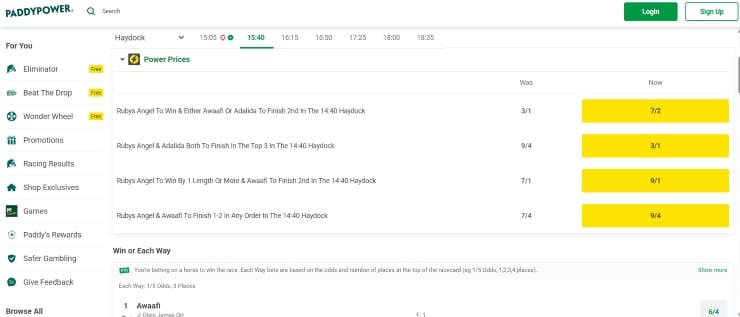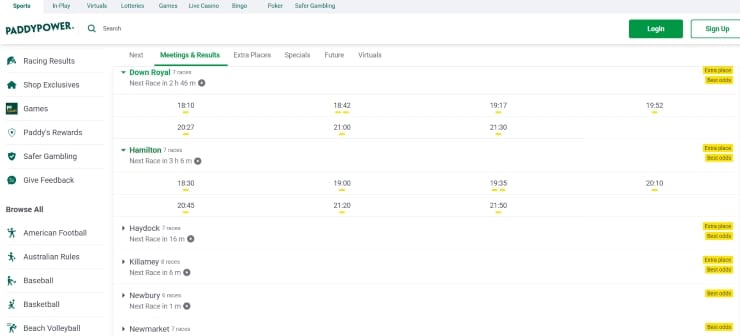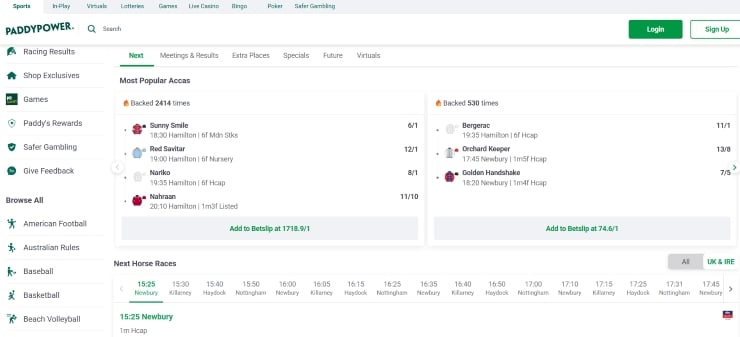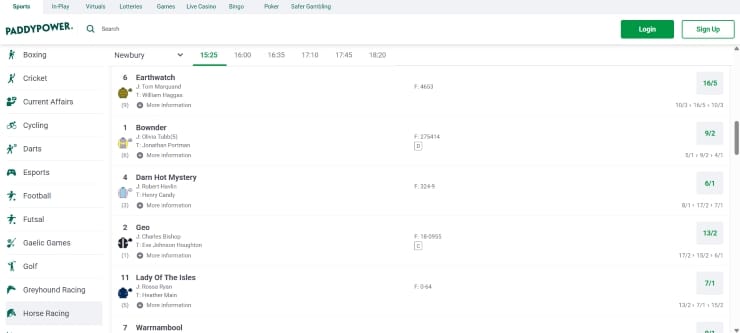How to Bet on Horses – The Basics Every Punter Should Know
Elliot Law, Senior Editor
Last Updated: 13/11/2025
Darragh Harbinson, Senior Editor
Fact-checker
In this guide, you’ll find everything you need to get started with horse racing betting. We’ll show you the basics of horse betting, types of bets, reading race odds and making informed picks – so you can enjoy the thrill without the confusion. Whether you’re at the track or betting online, this article is designed to simplify the process with expert-backed tips and practical advice, making it a fun way to dive into horse betting. If you’ve ever been curious about horse racing, this is your chance to dive in with a clear road-map tailored for first-timers.
- Show full guideShow less
Placing a Bet on Horse Racing in the UK
Betting on horse racing in the UK is a straightforward process once you know the steps. Whether you’re visiting a racecourse, popping into your local bookmaker, or using an online betting platform, here’s a simple guide to help you get started.
Betting at the Racecourse vs. Online
- 🐎 At the Racecourse: Place your bets at a betting window, with an on-course bookmaker, or at a self-service terminal. You’ll need to tell the cashier the race number, your chosen horse, the type of bet you’re placing, and how much you’d like to wager.
- 💻 Online Betting: Many UK betting websites and apps, like Betfair or Ladbrokes, allow you to bet from the comfort of your home or while on the go. Simply create an account, top it up with funds, and navigate the site to place your bets. The best online horse racing sites also provide useful tools like live odds and racecards.
Step-by-Step Guide to Placing a Bet
- Select the race: Look at the day’s race schedule (either in the racecourse programme or online) and choose which race you want to bet on.
- Pick your horse: Review the racecard to find the horse you want to back, identified by its number.
- Choose your bet type: Decide whether you want a Win, Place, Each-Way, or more complex bets like Forecast or Tricast.
- Decide your stake: Determine how much you’d like to bet. Remember, in the UK, stakes are often discussed in pounds and pence.
- Place your bet: At the racecourse, clearly state your selections to the bookmaker or cashier. Online, simply add your selections to your bet slip and confirm your wager.
- Keep your betting slip or confirmation: At the racecourse, you’ll get a printed betting slip. Online, you’ll receive a digital confirmation. Hold onto it—it’s proof of your bet.
Understanding Betting Slips and Confirmations
Your betting slip or online confirmation will include the details of your wager: the race time and number, the horse you’ve chosen, your bet type, and your stake. If your bet wins, you’ll either return to the bookmaker to collect your winnings or have them automatically credited to your online account. Always double-check your betting slip or confirmation to ensure everything is correct before the race starts.
Whether you’re betting at Ascot or enjoying a flutter from your sofa, horse racing betting in the UK is an exciting way to engage with the sport. Best of luck!
Horse Racing Betting Tips for Beginners
Getting started with horse racing betting can feel a bit daunting, but with a few simple tips, you’ll be on your way to having a fun and rewarding experience.
💡 Tip #1 Keep it Simple: Stick to Basic Bets
If you’re new to the game, it’s best to start with easy bets like Win, Place, and Each-Way. These are straightforward and a great way to understand the basics before moving on to more complex options like accumulators or forecasts.
💡 Tip #2 Do Your Homework: Research Horses, Jockeys, and Trainers
Knowledge is key when it comes to horse racing. Take time to read racecards, study form guides, and check stats on jockeys and trainers. Knowing how horses perform on different types of courses and under certain conditions, like soft or firm ground, can give you a solid edge or advantage when making your bets.
💡 Tip #3 Don’t Chase Losses
It’s easy to feel frustrated after a loss, but chasing losses is a common trap to avoid. Stay disciplined and stick to your betting budget. Increasing your stakes to recover quickly often leads to even bigger losses. A slow and steady approach is always better.
💡 Tip #4 Watch the Races to Learn
Watching live horse races, whether at the racecourse or on TV, is a great way to familiarise yourself with how races unfold while watching horse racing live. Pay attention to how jockeys position their horses, how races are paced, and how track conditions impact outcomes. Over time, this will help sharpen your instincts and betting strategies. Non-Gamstop horse racing sites often feature live streams of races for you to follow.
Jump into the world of UK horse racing with confidence, and remember that patience and preparation are the keys to success!
A Beginner’s Guide to Horse Racing in the UK
Horse racing is a staple of British culture, steeped in tradition and excitement. Whether you’re new to the sport or simply want to understand the basics before placing a bet, this guide will walk you through the essentials of horse places and betting.
Types of Horse Races in the UK
- 🏆 Flat Racing: The most common form of horse racing in Britain, held on flat, even tracks over a variety of distances. These races focus on speed and stamina.
- 🏆 National Hunt Racing (Jump Racing): Popular in the UK and Ireland, this type features horses racing over fences or hurdles, testing their agility and endurance. The Grand National is a prime example.
- 🏆 Novice Races: A race for horses who have not won one, two, or more races or a Class I race.
- 🏆 Handicap Races: Each participating horse is allocated a weight based on its skill and ability, evening out each horse’s chance at winning the race.
Key Horse Racing Terms
- Jockey: The skilled professional rider who guides the horse during the race. Their tactics and experience can significantly influence the result.
- Furlong: A traditional unit of measurement in British horse racing, equal to 1/8 of a mile (approximately 201 metres). Races in the UK are often measured in furlongs.
- Odds: Indicate the likelihood of a horse winning and determine your potential payout. Odds in the UK are usually displayed as fractions (e.g., 6/1), showing how much you stand to win for every pound you bet.
- Post Position: Known as the “stall” in the UK, this is where the horse begins the race. A favourable position can give certain horses an edge depending on the course layout.
How UK Races Are Organised and Scheduled
In the UK, horse racing events are held at racecourses across the country, such as Ascot, Cheltenham, and Epsom. A day at the races typically includes several events of varying distances and classifications, offering plenty of opportunities to place bets.
Prestigious race days, such as Royal Ascot or the Cheltenham Festival, feature high-profile races, larger prize purses, and significant betting activity. Understanding the schedule and the class of races (ranging from Group 1 to lower handicaps) can help you better plan your wagering strategy.
With this guide, you’ll be well-prepared to enjoy the thrill of horse racing while navigating its unique terminology and traditions. Best of luck at the races!
Horse Racing Betting Guide for the UK
Betting on horse racing is a favourite pastime in the UK, but understanding the types of bets available is key to making informed choices. From simple bets to more complex options, here’s a guide to help you get started with UK horse racing betting, including insights into single race options.
Win, Place, and Each-Way Bets
- Win: Place a bet on a horse to come first. If your horse wins, you collect your winnings. This is the simplest and most popular type of bet.
- Place: Bet on a horse to finish in one of the top positions (e.g., first or second, depending on the race). Payouts are lower than a win bet but offer more chances to win.
- Each-Way: This is essentially two bets in one: a win bet and a place bet. If your horse wins, you get payouts for both; if it places, you collect only the place portion. Each-way bets are common in UK racing, especially for larger fields.
Forecasts and Tricasts
These bets are more advanced but can yield higher rewards:
- Forecast: Predict which two horses will finish first and second in the correct order.
- Reverse Forecast: Cover all outcomes for one of your chosen horses finishing first and the other second (requires a double stake).
- Tricast: Predict the first, second, and third horses in exact order. This bet is much harder to win but offers larger payouts.
Accumulators and Multiples
For bettors looking to up the stakes, accumulators and multiple bets are popular in the UK:
- Double: Bet on the outcome of two races. Both selections must win for a payout.
- Treble: Similar to a double but covers three races.
- Accumulator: Combine four or more bets into one. All selections must win for the accumulator to pay out. While risky, the potential returns on acca betting can be massive.
Understanding Odds and Winnings
In the UK, odds are typically displayed in fractional format (e.g., 5/1). This means for every £1 staked, you win £5 (plus your original stake). Fractional odds are easy to understand: the smaller the fraction, the more favoured the best horse in the race. Larger fractions indicate an outsider with a higher potential payout.
The Tote Betting System
In British horse racing, Tote betting is a popular pari-mutuel system. All bets of a specific type are pooled together, and after the operator takes their cut, the remainder is divided amongst winning bettors. Tote odds can fluctuate until the start of the race, as they are based on the total amount wagered.
Tips for Beginners
- ✅ Start with simpler bets like win or each-way to get a feel for the system.
- ✅ Understand the odds and how they relate to potential payouts.
- ✅ If you’re feeling adventurous, try a small forecast or tricast bet for bigger payouts.
- ✅ Always set a budget and stick to it—betting should remain fun and responsible.
With this guide, you’ll be ready to enjoy the thrill of UK horse racing betting while making more informed decisions at the races or online!
How to Read Racing Form
Racing form is an essential tool for anyone serious about betting on horses. It’s like a detailed report card that gives you important information about each horse and race, helping you make smarter bets and identify the potential winner.
What Is Racing Form?
A racing form is a publication or digital report that provides data on horses, jockeys, trainers, and race conditions. It includes past performances, odds, and other details for every horse in a race. You can find racing forms at the track, online, or through various apps.
Key Info to Look For
- Past Performance: This section shows how a horse has performed in recent races, including finishing positions, race times, and the class of competition. Learn how to read horse racing form for consistent finishes near the top or recent improvements.
- Jockey Stats: The jockey’s experience and success rate matter. A skilled jockey can make a big difference, especially in close races. Check if the jockey has a strong record with the horse or at the track.
- Track Conditions: Horses perform differently depending on the track surface (dirt, turf, synthetic) and weather conditions (wet, dry, muddy). Look for horses that run well in the expected conditions of the upcoming race.
How to Spot a Potential Winner
- Look for horses with steady or improving recent performances.
- Favor horses paired with top jockeys or trainers known for success.
- Consider how the horse has performed on similar track conditions and distances.
- Pay attention to the horse’s post position and how that might impact the race.
- Use the racing form to compare odds and value — sometimes a horse with longer odds could be a smart bet based on its form.
Setting a Budget and Managing Your Betting Funds
When it comes to betting on horse racing, especially for beginners, managing your money wisely is key. A responsible approach ensures you can enjoy the sport without jeopardising more money than you can comfortably afford to lose.
The Importance of Sensible Betting
Betting should always be enjoyable and within your control. It’s easy to get swept up in the excitement, but chasing losses or betting impulsively can lead to financial issues. Setting a clear budget before you start helps ensure you don’t gamble money meant for essentials like rent, bills, or groceries.
Determining Your Betting Budget
First, decide how much money you’re comfortable dedicating to horse racing each week or month. This is your bankroll – a separate pot of money specifically for betting. Next, split this bankroll into smaller portions for individual bets. If you’re new to betting, start with small stakes to minimise risk while learning the ropes.
Bankroll Management Tips
- ⭐ Establish a budget: Only bet what you can afford to lose without impacting your daily life or financial commitments.
- ⭐ Keep your stakes consistent: Stick to a fixed amount per bet, such as 1-5% of your bankroll, to prevent heavy losses in a single wager.
- ⭐ Don’t chase losses: If you lose a bet, resist the urge to increase your stake in an attempt to recover your money. Stay disciplined and follow your plan.
- ⭐ Track your bets: Keep a record of your wagers, wins, and losses. This helps you evaluate your performance and refine your strategy as needed.
- ⭐ Take regular breaks: Betting can be intense, so step away every now and then to keep a clear head and avoid making emotional decisions.
By managing your funds responsibly, you’ll enjoy horse racing for longer while making smarter, more strategic betting choices.
Common Mistakes to Avoid
Betting on horses can be exciting, but it’s often daunting for beginners. To improve your chances and manage your budget wisely, avoid these common mistakes:
❌ Letting Emotions Rule Your Bets
Backing a favourite horse or supporting a local favourite can easily cloud your judgement. Emotional betting often leads to poor decisions. Instead, focus on research, form guides, and statistics to make informed choices.
❌ Jumping into Complex Bets Too Soon
Exotic bets like Forecasts and Tricasts may promise big winnings, but they’re far more challenging to win and tricky to understand. Stick to simpler bets like Win or Each-Way until you’ve mastered the basics and feel more confident.
❌ Overlooking Track and Weather Conditions
The track type and weather play a huge role in a horse’s performance. A horse that performs brilliantly on dry ground might struggle on heavy going. Always check the conditions on race day before placing your bets
Conclusion
Keeping up with horse racing news can deepen your appreciation for the sport. Follow official UK racing channels, subscribe to newsletters, and keep an eye on updates from local racecourses to stay ahead. You’ll gain expert tips, timely updates, and valuable insights into the exciting world of British horse racing.
Learning the ropes of horse racing strategies takes time. Start slow, familiarise yourself with the races, horses, and betting options, just like human athletes and don’t shy away from seeking advice from reputable sources. Above all, always gamble responsibly—set limits, never stake more than you can afford to lose in the betting ring , and focus on enjoying the thrill of the sport rather than chasing financial gains.
FAQs
What’s the difference between flat racing and jump racing for beginners?Flat racing involves horses running on level ground without obstacles, while jump racing (also known as National Hunt racing) includes hurdles or fences. Beginners might start with flat racing as it’s easier to follow, especially when only betting on one race or one horse. That said, both types offer exciting ways to get involved, whether you’re backing ponies or professional racehorses.How do I choose which horse to bet on in my first race?Start by reviewing the history of the runners, including how they’ve performed in previous races. Look at factors like form, track conditions, and whether a horse runs better on certain racetracks. Beginners might consider backing mid priced horses that offer a balance between risk and potential reward. Don’t forget to check the lucky number or name if you’re going with your gut!Can I bet on multiple horses in one race?Yes, you can bet on multiple horses in one race. This is common in exacta betting, where you pick two or more horses to finish first and second in exact order. Some even choose three horses or four horses to cover more outcomes. Betting on several horses can increase your chances to win money, especially if you’re unsure about which horse will cross the finish line first.Should I stick to one race or bet across multiple races?While betting on one race is simpler, some prefer to spread their bets across multiple races to increase excitement. At most tracks, you can place accumulator bets involving multiple horses across different races. Just remember, the more races involved, the harder it is to win — but the rewards can be greater if all the horses you select perform well.What’s the best strategy for beginners to follow at the racetrack?For beginners, start small and avoid betting on too many runners. Focus on one horse per race at first, and observe the ponies during the parade ring. Use racecards to check the history of the horses, including their performance on similar racetracks and in previous races. Watching how they behave near the start line and throughout the race gives valuable insight before you place a ticket.Is it better to bet on favourites or take a chance on other horses?Favourites often have a higher chance of winning, but the odds are lower. Betting on other horses, especially mid priced horses with decent form, can offer better value. Some seasoned punters mix it up — backing the favourite in some cases and three horses or more in others, depending on the field size and conditions. Ultimately, studying the racehorses’ records and race type — whether flat or jump racing — will guide better decisions.Resources
Elliot Law, Senior Editor
Elliot has a background in journalism which he combines with his extensive gambling knowledge to bring you in-depth, honest reviews, guides, and articles. After years in the field of iGaming and online sports betting, he aims to give you the hottest tips and guide you towards the best online gambling platforms in the industry.
This article has been Fact-checked by Darragh Harbinson
We prioritize accuracy, objectivity, and depth in every piece of content we produce. Our rigorous editorial standards ensure that all information is carefully sourced and fact-checked. Each article is meticulously reviewed by experienced editors and leading technology professionals to maintain the highest level of credibility and relevance. This commitment guarantees our readers content they can trust and rely on.
From breaking news and in-depth match analysis to exclusive interviews and behind-the-scenes content, we bring you the stories that shape the esports scene.
40k+Monthly Visitors
100%User Satisfaction
10+Years experience
Popular Pages
Explore Categories












